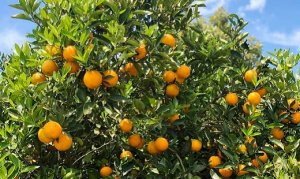 See photos
See photos
Piracicaba, 20th – The number of bids for contracts from the processing plants from São Paulo State increased in the second week of May, after Fundecitrus (Citrus Defense Fund) released, on May 11, estimates confirming orange production in the 2020/21 crop should be lower, which was already expected by agents from the sector.
Besides the higher demand from processing plants, prices rose too, hitting 5.00 USD per 40.8-kilo box, harvested and delivered to processors – this price level is very attractive, considering the current dollar level, which closed at 5.83 BRL on May 15.
Higher prices bring some relief to Brazilian citrus growers, since lower productivity increases unit cost of production. Before that, revenue could be constrained in the 2020/21 season, although price levels were similar to those in the 2019/20 crop.
According to Fundecitrus first crop estimates, orange production in the Brazilian citrus belt (São Paulo and Triângulo Mineiro) in the 2020/21 crop should be 25.6% lower than that in the previous season (2019/20), totaling 287.76 million boxes of 40.8 kilos – 12.5% lower than the average in the last 10 years.
Lower production is linked to the high production in the 2019/20 crop (which increased the consumption of nutritional reservoirs in plants and, consequently, reduced plants vigor) and the effects of the weather on flower settlement (hot and dry, primarily between September and October). Still, between March and April 2020, the low rain volume in the citrus belt limited fruits growth, according to Somar Meteorologia (weather forecast agency). Data from Fundecitrus indicate that production should be irregular among regions.
Also, in the 2020/21 crop, the first flowering should not be the largest, justifying forecasts for a late crop – crushing should only start from June. According to Fundecitrus, the fruits from the first flowering should account for 32.9% of the crop, from the second flowering, for 52.3%, from the third flowering, for 12%, and from the fourth flowering, for 2.8%.
INVENTORIES – The smaller harvest should result in lower orange juice production along the 2020/21 crop. Thus, despite the forecast for an inventory offset at the processing plants from SP by the end of the 2019/20 season (June/2020), lower supply shows that prices tend to continue positive to growers (in both the in natura market and the industrial segment), since, in June/21, orange juice availability may be similar or even lower than the strategic level. This scenario may also push up orange juice prices in the international market.
Cepea calculations show that Frozen Concentrate Orange Juice (FCOJ) Equivalent inventories may total around 250 thousand tons in June 2021, considering the initial inventories estimated in February by CitrusBR (Brazilian Association of Citrus Exporters), of 412.8 thousand tons, with 238 million boxes of oranges crushed (and 50 million boxes remaining for the in natura market), stable sales and average yield similar to that in the last five crops.
However, it is worth to mention that the ending stocks of orange juice still depend on the volume sold (from both the 19/20, which may result in lower initial inventories, and the 20/21 seasons) and on the real amount to be crushed, besides industrial yield, which may change.
BRAZILIAN MARKET IN MAY – Tahiti lime prices (paid to growers) skyrocketed in the first week of May, but weakened at the end of the fortnight. According to Cepea collaborators, the resume of exports and lower supply pushed up prices for this variety.
In the first half of May, the average price for tahiti lime closed at 28.82 BRL per 27-kilo box, harvested, 65% up compared to that in the first fortnight of April.
As regards oranges, prices dropped in the in natura market of São Paulo in the first fortnight of May, influenced by the higher supply of early varieties and the still low purchases from processing plants. Besides, temperatures decreased, reducing the demand for the fruit.
Between May 1 and 15, the average price for hamlin oranges was 21.03 BRL per 40.8-kilo box, on tree, 20% down compared to that in the first half of April. For pear oranges, the average price was 26.49 BRL per box, 22.3% down in the same comparison.
Baía orange sales also constrained price rises for other varieties, as baía oranges have reached the ideal quality and size for trading.
Source: hfbrasil.org.br